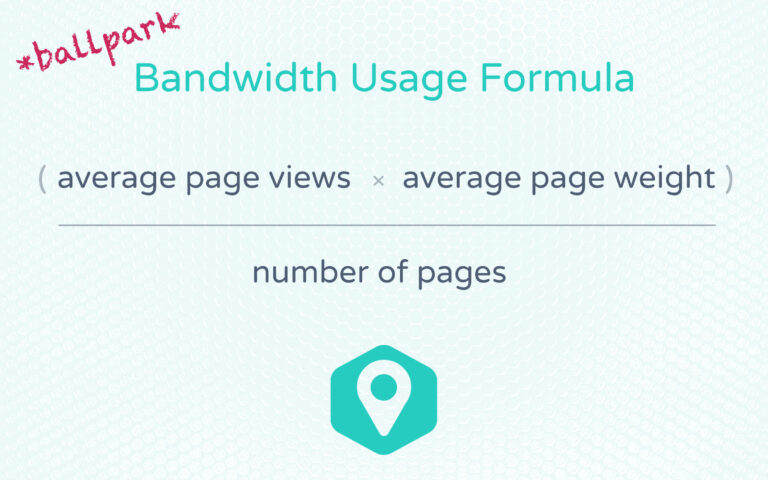Some hosts & CDNs charge by the GB transferred. Want to know how much it costs? Here’s how to find your website’s traffic volume in MB or GB.

Most of these companies charge for data transfer, not storage.
That means it doesn’t matter how many files you upload or how big they are.
And technically it doesn’t matter how many visitors you get. It’s the combination of files and traffic that makes the difference. Or, put more simply:
It only matters how much people are downloading from your site.
Use this tool to calculate your website’s estimated bandwidth usage and plan out your hosting and/or CDN costs.
Use this calculator to figure out your website’s bandwidth usage. More info on this calculator is below.
[bandwidth-calculator]Credit to CalculatorWeb for building a great, full-featured version of this calculator.
Website Bandwidth Usage Formula
Here’s a rough ballpark formula for calculating your website’s bandwidth usage.
(Average monthly page views * average page weight) / number of pages

Why is it a rough ballpark?
Good question.

To get an exact number, you’d need to know exactly how many visitors your site saw to each page, and how much of each page was served (i.e. did the user bounce before the page had fully loaded?).
And there’s more.
You’d need to know how many assets were download that may not have their own “page” per se. Things like PDFs downloaded or images/MP3s accessed directly by their unique URL.
See?
Figuring out those numbers exactly would be really hard.
If your hosting provider offers services like Plesk, cPanel, etc., then your hosting account stats (or support department) may be able to tell you exact numbers.
If you’re on GoDaddy’s Managed WordPress or other similar, shared VPS, you’re probably out of luck on those exact stats.
Bonus: we use WP Engine for all our clients and we LOVE it.
Not sure?
Here you go: how do I tell where my website is hosted?
How to get as close as possible
Ok so we know the above formula gives you a rough ballpark estimate on your website’s bandwidth usage.
But how can you get that bandwidth usage estimate as accurate as possible?
Two big things to consider:
- Scope — get a big sample size
- Distribution — which pages see the most traffic?
Scope: make sure it’s representative
We’re making an educated guess about your traffic. So we need to be well-educated.
Expand your Google Analytics scope to at least one year.
[screenshot of GA datepicker]Using an entire year gives you a long timeframe to work with. That way you can see patterns in your traffic.
That’s the key.
What do the patterns look like?
Focus on what traffic usually looks like. Make note of peaks and valleys, but the long-term typical trends are most important here.
If you’ve seen significant changes in traffic recently, you may need to focus your scope to ignore the change.
For example, if your site hit the front page of Reddit recently, you probably saw a huge spike in traffic.
[screenshot of traffic spike in analytics]Unless you’re one of those wizards able to hit the front page every time, that spike probably ended as fast as it started.
Therefore that spike is not representative of your typical traffic numbers.
To recap:
- Focus on a long scope so you can see patterns
- Ignore atypical changes
- Be realistic about what’s “typical” ([[[did you lose your ranks in Google again?]]])
Distribution
Now that you’re looking at a representative scope to see your traffic patterns, it’s time to make sure you’re being realistic about where that traffic is going.
It’s simple:
Which pages are most visited?
Find the pages and assets on your site that see the most traffic/downloads. The more times someone downloads a file (remember: “pages” are just collections of files), the more bandwidth gets chewed up.
[screenshot of top pages in GA]For example:
Our post on Content Marketing 2017 and our Local SEO for Real Estate Guide are our most-visited pages.
[screenshot of graph]So it makes sense for us to weight these pages—and all the assets linked & embedded on them—more heavily in our calculation.
Weighting popular pages
Sounds hard. Isn’t.
Find the unique page views to your most popular pages. Divide that by unique page views to ALL pages combined.
That gives you a percentage. I.e. maybe your killer blog post makes up 35% of all traffic. It should get 35% of the weight….
Example numbers
5,924 views / 30 days = 197.46666667 views/day
homepage 2.3mb
51 successful URLs == 20840433 bytes == 0.020840433 GB
51 / 377 URLs == 0.1352785146
51/0.1352785146 == 377
0.020840433 GB / 0.1352785146 == 0.1540557498 GB average
Sitemap generator
Use a sitemap generator to find the file size of every page on your site: http://www.auditmypc.com/xml-sitemap.asp
- Don’t use Chrome
- CSV sucks in Numbers

The calculator isn’t working . It refreshes the page from start
Thanks for letting us know. We’ll look into it asap!